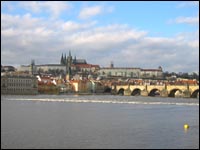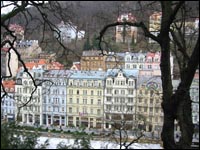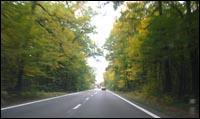 For
Travellers For
Travellers |
Tips
Nationals of all Western European countries can
visit the Czech Republic for up to 90 days, and
UK and Irish Republic citizens for up to 180 days,
without a visa. US and Canadian passport holders
can stay for 30 days without a visa. Nationals of
Australia, New Zealand, South Africa and many other
countries must obtain a visa, which is good for
a stay of between 90 and 30 days depending on your
nationality.

Time: GMT/UTC plus one hour
Currency: Czech crown (Kc)
Exchange rate: US$1 = 29 Kc
Electricity: 220V, 50 Hz AC
Weights & measures: Metric
Tourism: 17 million visitors/year
Costs in the largest tourist centers
Prague especially, but also the Bohemian spas, are
more expensive than elsewhere, though things are
still fairly cheap for Western visitors. The big
exception is accommodation in Prague, for which
tourist prices are in line with those across Western
Europe. By staying at cheap hostels and campsites,
sticking to self-catering, pub grub and stand-up
cafeterias, you might get away with US$15 per person
per day in summer. In a private home or better hostel,
with meals at cheap restaurants and using public
transport, you can get by on US$20-25. To share
a clean double room with bath in a mid-range hotel
or pension, and enjoy good local or Western meals,
plan on at least US$30-40. In Prague, figure a third
to half again as much, and even more if you want
to be close to the centre. On the other hand, except
for Easter and Christmas-New Year, many bottom and
mid-range hotels drop their prices by a third or
more outside the summer season.

Travelers' cheques are easily enchased throughout
the Czech Republic. Eurocheques are cashed free
of charge at Komercní banks, and there are
American Express and Thomas Cook offices in Prague
which will change their cheques at bank rates free
of charge (though it is recommended to check well
before changing money because some of them apply
very bad rates). Upper end hotels and restaurants
in major tourist centers accept some credit cards,
usually American Express, Visa or MasterCard (Access)
and sometimes Eurocard, Diners Club or JCB. Most
travel agencies and some tourist shops in Prague
accept credit cards, but most shops prefer crowns.
American dollars and German marks are also commonly
accepted. Don't bother exchanging money on the black
market: the usual rate is barely above the bank
rate and there are plenty of scammers ripping off
tourists with discontinued old crown notes or worthless
Polish zlotys.
A tip of 5-10% is appreciated in any tourist restaurant
with table service. The usual protocol is for them
to tell you the total food bill and for you, as
you hand over the money, to say how much you are
paying with the tip included.
When to travel to the Czech Republic
May, June and September are the prime visiting months,
with April and October as chillier and sometimes
cheaper alternatives.
|
Most Czechs take their
holidays in July and August when hotels and tourist
sights are more than usually crowded, and hostels
are chock-a-block with students, especially in Prague
and the Krkonose and Tatras mountain resort areas.
Luckily, the supply of bottom end accommodation
increases in large towns during this time, as student
hostels are thrown open to visitors. Centers like
Prague, Brno and the mountain resorts cater to visitors
all year round. Elsewhere, from October or November
until March or April, most castles, museums and
other tourist attractions, and some associated accommodation
and transport, close down.

State Holidays
1st January Independent Czech State
8th May Liberation Day
5th July Slavic Apostles St. Cyril and St. Methodius
6th July Burning of Jan Hus
28 th September Czech Statehood Day
28 th October Independent Czechoslovakia Day
17th November Fight for Freedom and Democracy
Transports
By plane
The Prague International Airport (PRG) is the air
gate to the Czech Republic. The airport provides
daily connection from and to major European cities,
but other destinations can be reached via other
airports such as Frankfurt, London, Amsterdam and
Paris.
By train
It is easy to get to the Czech Republic from all
major European cities by train. Most international
trains arrive at Praha Hlavni Nadrazi (the Main
Station) but several trains go to other stations
such as Praha Holesovice, Praha Smichov and Praha
Masarykovo Nadrazi. All these stations have metro
stops and are easily accessible.
By bus
Bus is the cheapest way to travel across Europe.
The Czech Republic provides connection from and
to major European cities several times a week. Most
international buses arrive to Prague to Florenc
(the Main Bus Station). A few buses go to Roztyly.
By car

The Czech Republic is covered with a network of
generally good roads; old routes often go through
villages and small towns. There are some 500 km
of European-style motorways, the main ones being
the D1 or E50/E65 between Prague and Brno. The traffic
on motorways and country roads tends to be light
Source: Lonely Planet.
|

